
FLAG
White crescent and a star of five points on a field at
the canton and navy blue at the fly.The white denotes a
sovereign, red a warrior and blue the universe. |
|
|

EMBLEM
The crown denotes the Ruler. The four stars at the
corners of the white shield stand for the four original
districts of the State, namely Johor Bahru,Muar,Batu
Pahat and Endau. The star and crescent signify Islam.
The two tigers rampant recall the period when wild
beasts roamed the State. The floral decorations below
the shield represent gambier and black pepper, the two
original main products of the State. The State moto
reads "In the Hands of Allah". |
Back
To Top

FLAG
Red crescent and green shield with wreath of yellow
against red background. Red, the traditional colour of
the state, signifies prosperity.The crescent signifies
Islam. The shield symbolises the role of the ruler as
the protector and guardian of his subjects and all the
inhabitants of the state from unjust government. |

EMBLEM
The wreath of paddy stands for the State's principal
product. The crescent stands for Islam The shield stands
for strength and authority. |
Back
To Top

FLAG
White emblem on red background. The red background
signifies the loyalty of the people of Kelantan. The
white emblem stands for the sanctity of the office of
the Ruler. |
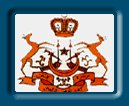
EMBLEM
The crown stands for the sovereignty of the Sultan. The
two spears and two keris signify the power of the
Kelantan Malays.The star and crescent signify Islam. The
two cannons signify that the State is ever ready to
defend itself. The two deers serve as reminders of the
period in the State's history when Che' Wan Kembang (or
Che' Siti), queen of Kelantan (roughly at the end of the
14th century), ordered the State's gold coinage to be
stamped with the design of these deers for which she
held such a deep affection. The State motto
reads:"In God, the Government of Kelantan
Submit". |
Back
To Top

FLAG
Top left hand quarter:royal blue with yellow crescent
and yellow five-pointed star. Top right hand quarter in
red and the lower half in white. The red, white, yellow
and blue are the colours of the flag of the Federation
of Malaysia and show that Melaka is a member-State of
the Federation. The star and crescent represent Islam,
the religion of the State and of the nation. |

EMBLEM
The various colours are the colours of the Federation of
Malaysia and indicate that the State is part of the
Federation. The five keris represent the five famous
warriors of old Melaka. The star and crescent stand for
Islam, the religion of the State. The Melaka tree is the
tree from which the State derives its names. The two
mousedeer supporting, the shield serve to recall the
incident involving the mousedeer which led the first
ruler of Melaka to choose the site and found the city.
The State motto reads:" Unity is Strength" |
Back
To Top

FLAG
The field is yellow, representing the Ruler.The canton
in the top left hand corner is in two colours which
divide the it diagnolly, the lower triangle being black
representing the four Undangs (major chiefs), and the
upper triangle being red, representing the rakyat. |
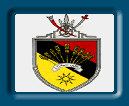
EMBLEM
The nine sheafs of rice on the shield denote the nine
states in the federation of Old Negeri Sembilan. The red
in the shields reflects the past British connection. The
black denotes the Undang, the yellow the Yang Dipertuan
Besar. The nine-pointed star also stands for the nine
states of Old Negeri Sembilan.The sword and its sheath
above the shield represent justice. The changgai puteri
between the sword and its sheath represent the
sovereignty of the Ruler |
Back
To Top

FLAG
It was originally black,symbolising the Bendahara who
held the appointment at the behest of the sultans of
Johor-Riau of which Pahang was formerly was part. In the
1880s when Bendahara Wan Ahmad proclaimed himself Sultan
of Pahang, the royal white was added to the flag to mark
his rise in status. The flag consists of two equal
horizontal stripes of white and black, the white being
above. The white now represents the Ruler while the
black represents the rakyat. |
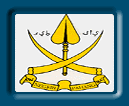
EMBLEM
The head of the spear, one of the elemens of the State
regalia, symbolises the sovereignty of the Ruler. It
will be observed that the head of the spear is not
commensurate with its length; this is because it is
meant to represent the shape of a coffee-tree
leaf.According to tradition Sultan Ahmad, who had made
many attempts to gain the throne of Pahang, foresaw his
final triumph as the result of an incident which
involved a cup of coffee served to him whilst in
Terengganu preparing for a final assault. The Malay
Annals the elephant had close associations with Malay
rulers and their protocol, in particular their use as
royal transport. |
Back
To Top

FLAG
The Perak is divided into three horizontal bands of
equal size,in white(upper),yellow(centre) and
black(lower). These three colours represent the three
branches of the royal family amongst whom the throne is
shared in rotation. The band stands for the Sultan, the
yellow for the Raja Muda and the black for the Raja
DiHilir. |

EMBLEM
The crest worn by the Ruler on his tengkolok symbolises
his sovereignty. The crescent stands for Islam, the
official religion. The rice flower stands for
paddy-planting, the prime occupationof the people. |
Back
To Top

FLAG
It consists of two horizontal stripes of equal size, the
upper band following being yellow and the lower band
blue. The yellow stands for the Ruler, the blue for the
people. The flag therefore symbolises the close
relationship between Ruler and the people. |

EMBLEM
The wreath of paddy represents the primary occupation
and main product of the State. The shield represents the
pride and honour of the State. In general, the emblem
reflects the pride of the State in being a rice granary. |
Back
To Top

FLAG
The flag is a tricolour consisting of vertical stripes
of equal width of light blue (at the hoist), white and
yellow; on the central (white) stripe is an areca nut
palm or pokok pinang on a mount.Light blue signifies the
sea which surrounds the island. The white represents the
State itself in its serenity. The yellow signifies
prosperity. The betelnut tree is the tree from which the
island takes its names |
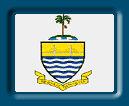
EMBLEM
The betelnut tree gave the island its name. The Penang
Bridge is not only a source of pride to the people of
Pulau Pinang, it also unites the island with the
mainland part of the State, as well as symbolising the
unity between the State and the Federation. The two
pillars of the bridge stand for two basic features of
the New Economic Policy, namely the eradiction of
poverty and restructuring of society, while the four
cables represent the four major races in the nation,
that is Malay, Chinese,Indian and others. The five blue
and white waves symbolise the five Rukunegara and
also the five administrative districts of the State. The
five colours at the base of the betelnut tree have the
same meaning. |
Back
To Top

FLAG
The flag is rectangular in the proportion 1:2. The
canton which extends at the head halfway to the fly and
2/3 of the hoist to the foot is icicle blue as the
background to a silhouette of Mount Kinablu, in royal
blue, positioned t 1/6 of the height of the canton. The
fly is divided equally into three bands of colours, the
foot of which extends to the hoist.The top band is
zircon blue, followd by white and chille red.
The new flag and emblem of Sabah are officially
established on 16 Sepetember 1988. The new State emblems
are very similar to the State flag and crest adopted
when Sabah joined Malaysia in 1963 but which were
replaced in 1981 under the administration of Berjaya
Party (1976 - 1985). |
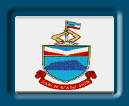
EMBLEM
The State crest consists of two arms in yellow holding
up the State flag resting on a band of five State
colours; zircon blue, chilli red, white, icicle blue and
royal blue.Immediately below is the main crest in the
form of a shield with its top segment carrying the three
of main colours, zircon blue, white and chilli red in V
bands. At the lower segment is the silhouette shape of
Mount Kinablu in royal blue against a plain icicle blue
background. The shield is rested on a red scroll
carrying the State motto "Sabah Maju Jaya" in
blue.
The two arm symbolises unity and cooperation among the
State's multi-racial communities for progress and
success of the country. The five colours represent the
five divisions in the State.
Zircon blue symbolises peace and tranquility, white
purity and justice, chilli red courage and conviction,
icicle blue unity and prosperity and royal blue strength
and cooperation. The silhouette shape of Mount Kinabalu
symbolises the State of Sabah. |
Back
To Top

Since 1988, the State has adopted a new flag, state
crest, state motto and state anthem.
FLAG
Red: symbolises the courage, determination and
sacrifies of the people in their tireless pursuit to
attain and maintain progress and esteem in the course of
creating a model state.
Yellow:denotes the supreamcy of law and order,
unity and stability in diversity.
Black:symbolises the rich natural resources and
wealth of Sarawak such as petroleum, timber, etc. which
provide the foundation for the advancement of the
people.
The yellow nine-pointed Star denotes the nine
divisions where the people live in harmony. The star
symbol also embodies the aspiration of the people of
Sarawak in their quest to improve their quality of life. |

EMBLEM
The state crest is represented by a symbolic figure of a
wingspread Kenyalang(Hornbill) - the State bird.
Its 13 wings and 13 tail segments represent the 13
states of Malaysia.
The Bunga Raya (Hibiscus) - the national flower
appears on the right and left of the bird's legs while
the banner or ribbon on which the bird's stand carries
the new State Motto "Bersatu, Berusaha, Berbakti"
(United, Industrious, Dedicated).
Positioned on the bird's chest is a shield bearing the
state colours-black, red and yellow. |
Back
To Top

FLAG
It is yellow and red in quarters, with a white crescent
and star in canton. Designed in the reign of Sultan
Abdul Samad, the yellow and red symbolises flesh and
blood. The crescent and star are symbols of Islam, the
white representing its purity. |
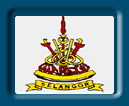
EMBLEM
The crescent and star represent Islam, the State
religion. The red spear in the center with a short keris
to the right and a long keris to the right and a long
keris to the left are part of the State regalia. The
jawi writing expresses the State motto, namely:
"Under the protection of Allah". Below the
motto appears the broad belt (tali bengkung) or sash
worn at the waist by warriors in the past. |
Back
To Top

FLAG
Horizontal black band against white background; white
crescent and star in centre. The white background
signifies the Ruler.The fact that it surrounds the black
field - representing the people - signifies the
protection the Ruler gives to his subjects. The star and
crescent stand for Islam, the State religion. |

EMBLEM
The crescent and the star above indicate that Terengganu
is an islamic State. The crown symbolises the
sovereignty of the Ruler. The sword, long kris and the
mace represent the authority of the State. The book on
the right represents the Holy Quran. The book on the
left represents the kitab. The kain dukong symbolise the
appurtenances of Malay royalty. |
Back
To Top |
![]()